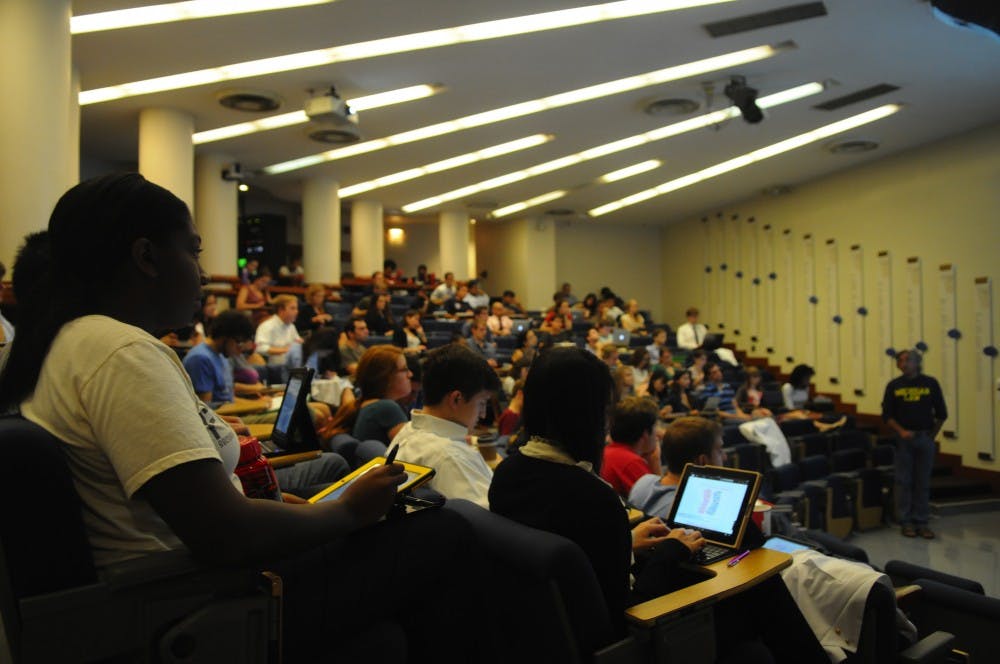
Third-generation iPads are replacing 800 pages per week of written notes per week for medical students.
Upon arriving at Penn, incoming first-year and second-year medical students at the Perelman School of Medicine each received a 32 GB iPad as a gift to kick off the year.
In the past, the Medical School would collate and copy paper-based course materials and deliver them to students’ mailboxes, totalling more than 3 million sheets of paper per year.
But the school’s iPad program aims to do much more than reduce paper costs or help the environment. It represents a shift toward a new way to teach and practice medicine.
Several other medical schools have provided their students with iPads in the past two years, recognizing their potential to create a portable and interactive learning environment.
At Penn, the idea to bring iPads to the curriculum didn’t come until last winter.
“We wanted to go into this thinking, ‘What are the things we need to do to make sure this actually works?’” said Gail Morrison, senior vice dean for education and director of the Office of Academic Programs at the Medical School.
A great deal of work took place behind the scenes before the school formally rolled out the program. The school’s curriculum developers worked closely with the Department of Information Technology to increase wireless connectivity in classrooms.
“You have 100 students in a classroom, but there are 100 more right across the hall, and most students have more than one device that’s wireless,” Morrison said.
Through the program, Penn is aiming to do more than just digitize paper materials.
“We wanted to expand and improve on [our resources] at the same time,” said Neal Rubinstein, associate professor of cell and developmental biology.
Using a program called iBooks Author, professors can create multi-touch textbooks that can include pictures, videos, interactive diagrams and hyperlinks. Students can type notes on the margins and highlight content.
“We discovered that we could tailor material to our own courses,” Rubinstein said. “And the other nice thing is if we want to change anything in the slides last minute — which we all do — we can.”
Third-year medical and doctoral student Christian Hinderer believes the iPads may make lectures more productive.
“During class, often you’ll hear everyone shuffling through their notes, only to find that slide wasn’t in there,” he said.
Rubinstein agreed.
“Faculty are finding this a pleasure to use, and it’s going to free our time to produce new materials,” Rubinstein said.
He explained that professors are now able to quickly update a slide or page of an iBook, and that “the key is to give the most accurate information.”
Before formally implementing the initiative, the Medical School ran a pilot program in order to get students’ feedback.
Third-year medical and doctoral student Jerome Molleston had been using his own personal iPad for six months before he was approached about participating in the pilot.
“I had been doing it ad hoc — I already did everything completely electronically,” he said.
Second-year medical student Maren Shapiro was initially reluctant about replacing paper with iPads.
“It was tough the first week, but I found I could easily take notes using a stylus,” she said.
The iPads given to students are entirely customizable, with nothing pre-loaded. Students are able to download and organize materials as they see fit, as well as choose which apps to use for note taking and clinical work. Some choose to use a Bluetooth keyboard, while others continue to take notes on their paper binders and use the iPad to watch lectures.
During their work at the Hospital of the University of Pennsylvania, students can access patient data in the hospital’s encrypted network through their iPads.
“You can zoom into a specific EKG wave and tell [the patient] what’s happening in one specific heartbeat,” Molleston said.
Physicians can also use the same resources if they have their own iPad.
“A couple of doctors started bringing in their iPads after seeing that I brought mine in every day,” Molleston said. “I think a transition is going to happen very quickly.”
“I think it’s very exciting,” Morrison added. “Knowing how medicine was when I came through to where it is today, it’s what they’d write about in books. This is the start of a disruptive innovation.”
The Daily Pennsylvanian is an independent, student-run newspaper. Please consider making a donation to support the coverage that shapes the University. Your generosity ensures a future of strong journalism at Penn.
DonatePlease note All comments are eligible for publication in The Daily Pennsylvanian.







